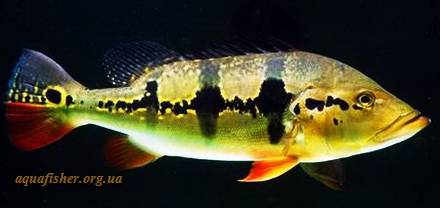
Cichla temensis
FAMILY
Cichlidae
TAXONOMY
Cichla temensis Humboldt, 1821, Rio Temi, Venezuela.
OTHER COMMON NAMES
English: Peacock bass, tucunare; German: Humboldtcichlide;
Spanish: Pavуn.
PHYSICAL CHARACTERISTICS
Maximum length 39 in (99 cm); perhaps the world’s largest cichlid.
Elongate with large head, has superficial appearance of a
bass. Spinous and soft-rayed dorsal fin subdivided. Background
color yellow green to tan, with three dark vertical bars and a
series of horizontal rows of cream-colored spots. Ocellus on
caudal fin; red on pelvic, anal, and lower lobe of caudal fins.
Males acquire nuchal hump during spawning.
DISTRIBUTION
Amazon Basin in Rio Negro and Rio Uatumг systems;
Orinoco basin in Venezuela and Colombia; introduced in
Florida and Texas.
HABITAT
Along banks of main river channels over sand and rocks, and in
deeper inshore waters of lagoons.
BEHAVIOR
Voracious predators; in aquaria, they ignore any fishes that are
too large to swallow.
FEEDING ECOLOGY AND DIET
Feeds on other fishes.
REPRODUCTIVE BIOLOGY
Monogamous substrate spawners. Both parents care for eggs
and young. Eggs may number up to 4,000, and are laid on
logs, rocks, or in excavated pits.
CONSERVATION STATUS
Not listed by the IUCN.
SIGNIFICANCE TO HUMANS
Popular sport and food fishes. Also found in the aquarium
trade.
Other popular Animals
Photo Gallery of - Speckled pavon





 Animalia Life
Animalia Life